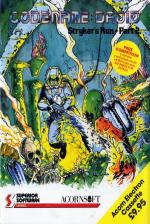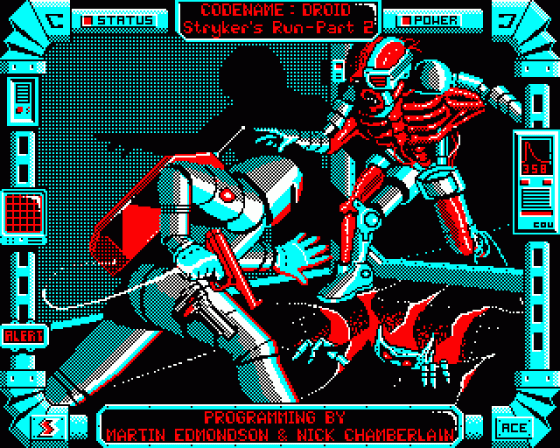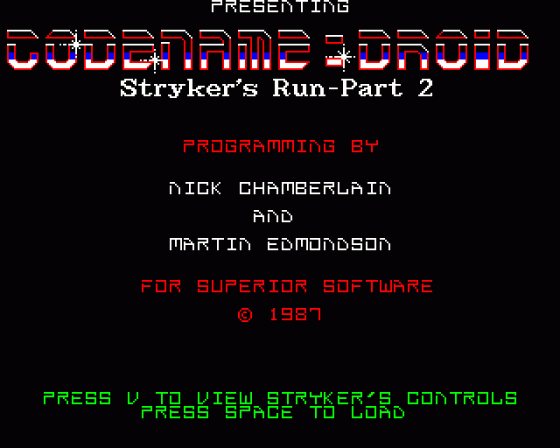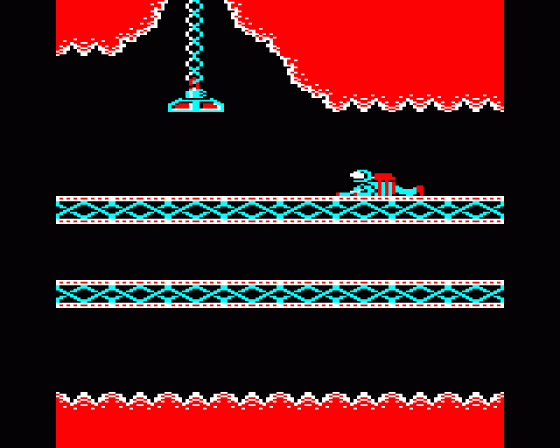
Everygamegoing
 26th August 2018
26th August 2018
Categories: Review: Software
Author: Dave E
Publisher: Superior/Acornsoft
Machine: Acorn Electron
Published in EGG #013: Acorn Electron
Codename: Droid
We first met John Stryker, the Electron's wannabe hard man, in the colourful Stryker's Run, in which he was seen continually running from left to right and bobbing in and out of spacecrafts. Codename: Droid is the sequel to that game and in many respects it's a megagame. Again you play John Stryker, but on this occasion, there's a lot more to do than just run. Codename: Droid is a large(ish) arcade adventure, set somewhere either in space or in a future where jetpacks have been invented. You must locate and seize an enemy spacecraft, the Z11.
The game thundered onto the gaming scene rather unexpectedly (September 1987) and, like many Electron games, never made it to any other formats. It received one of the warmest receptions ever, with wall-to-wall praise. A&B called it "a true piece of software entertainment" and demanded its readers "buy this game now!" But, for some reason, I didn't. Neither did anyone I knew who had an Electron. The megagame-in-the-making sat unloved on the shelves of the software retailers. The Acorn Electron disk version of the game only sold in single numbers!
I suppose sometimes a game that really is "the bomb" just fails to spark. It may be that it just came at a peculiar time, too early for Christmas and just when Acorn Electron owners were saving up in order to buy Acorn's new machine, the Archimedes, which seemed much more sophisticated. Or perhaps it just didn't catch the imagination because, where Stryker's Run is simplicity itself to play, Codename: Droid needs a hearty trawl through the instructions before you'll be able to get very far in it at all. Whatever the case, it's a great shame because the press had got it spot on. Codename: Droid is a good game. Considering the year of its release, it's a very good game.
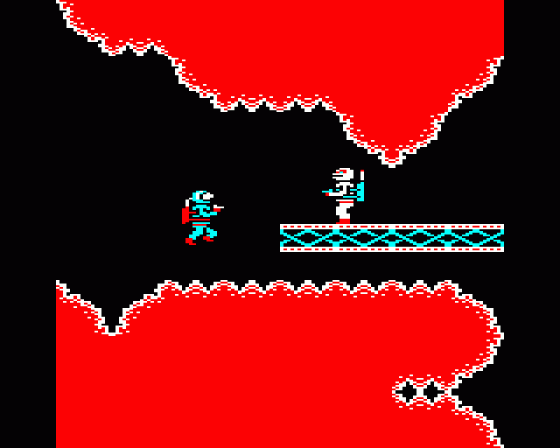
You start the mission in some caverns, next to a big spaceship (which I assume is your own). All is quiet on this initial screen and you must proceed right, whereupon you meet your first enemy Volgan soldier who stands to attention, firing impassively in your general direction. If you're familiar with Stryker's Run, you'll recognise this dynamic. The original was colourful but lacked any kind of sophistication in terms of enemy AI; they would similarly just sort of "stand there". A well-timed bullet will see him collapse into an animated skeleton (again, familiar) and allow you to proceed through the next few screens. In these you'll meet the second type of soldier. This one runs back and forth as if his pants are on fire and will fire at you if you're standing in front of him (but not if you're even a few pixels out of his line of sight). Again, this is precisely the same "attack" pattern as Stryker's Run and there's no great difference between the two games.
So far, so blah... However, the game now begins to reveal some of its hidden depths. Now, this was long before the days of 'in-game tutorials' so what tends to happen, especially if you're the type of player who thinks instructions are for losers, is that you suddenly find you can't get any further. For example, a screen presents a dead end but with a rope just out of reach. Here you find that jumping towards it from the left or the right allows Stryker to seize it. Now, by using two different keys, you can climb and descend the rope, and leap to another platform to continue. Another example is that, in Stryker's Run you had unlimited bullets. In Codename: Droid, going on a blastathon will empty your blaster in a few seconds. However, those batteries lying about the caverns will give it a much-needed top up.
Which brings me to the "wristwatch". This is activated by pressing A and is the sort of gadget James Bond would find himself equipped with. You can't refuel your blaster without activating the wristwatch and moving a battery to it. The same goes for your energy suit; the protection being offered by it decreases each time you take a hit yourself. There's no on-screen energy bar, and there's no on-screen "blaster energy" bar, so you'll need to consult the wristwatch every time you have a natural break in the fighting, just to make sure you're not at death's door.

Just when you think you've mastered this art, you'll stumble across your first jetpack. Walk into this and it will automatically strap itself to your back and allow you to float around, rather than run and jump. This also had its own activation panel, accessed with key J, with its own energy level (The jetpack will disappear when depleted to zero) and its own blaster (wholly separate from the one in Stryker's hands).
The labyrinth of caverns is also linked by elevators which work only if you've collected a passcard beforehand. The game is laid out in such a way that you need to make mistakes in order to learn what *not* to do, and, indeed, if you still haven't read the instructions, you may well consider it 'bugged'. This is because the elevators don't just move up and down, they also expect a 'payment' from their passenger. For example, if you have one passcard and you jump in the first elevator you find and go straight up, you'll find yourself in a small room but the elevator will have taken your passcard as payment for the trip up. Hence it will now stubbornly refuse to move at all, leaving you with no option but to press the Escape key and restart the game.
The jetpacks are also both a blessing and a curse. When you find your first one, you may well be excited enough to just experiment a bit with it. Whooosh! Fun, indeed. But you need that jetpack to leave the first section and proceed to the "Ancient Shrine" section, and if you don't work that out before it disappears, you're also stranded with only the Escape key to put Stryker out of his misery.

Codename: Droid features something that was ahead of its time, an automatic save when you enter a new section. Pressing J on the title screen will take you to the entrance to the Ancient Shrine or the Crew's Quarters with the precise amount of energy (and lives) as when you most recently entered them. Unfortunately, it's a bit useless as a feature if you've already made some hideous error - i.e. exhausted the jetpack - before you reached the autosave point.
There's also one more addition over the prequel too - the ability to crawl. Rather like Exile (which arrived thirteen months later), Stryker can get through the gaps in caverns by throwing himself onto the ground and then crawling through them. Unlike Exile, he doesn't stand up when you release the crawl key, and, bemusingly, he cannot crawl from one screen to another. This seems to be a very odd restriction and makes for one of the irritations of Codename: Droid.
The other irritations are few and far between but they are there. The odd autosave we've already touched on, but by far the biggest annoyance is the non-intuitive game controls. * (star) is most usually used for up, but here is used to fire the blaster, with + (plus) used instead, and > to descend. There are game controls for obscure things, like O to abandon the jetpack and D to drop a mine (when you've collected one of these other weapons). RETURN jumps but * gets in the way, meaning you're constantly firing instead of jumping and then, conversely jumping instead of firing. When you're crawling you have to tap + twice to stand up again. When you're perched on a rope you have to jump from it not to fall straight down.
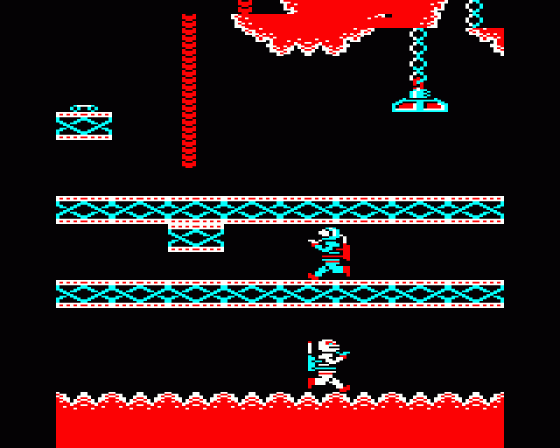
The "hidden" energy bars on the wristwatch feature are either a great way of making the space caverns feel fully immersive or, depending on your point of view, an omission that makes the game overly complex and silly.
It's truly curious that Codename: Droid was overlooked by most Electron owners and I daresay many of you reading this will have never actually heard of it. And yet I can't help but feel that there's "something" in those overcomplicated instructions, and those first few empty screens, that somehow puts the average player off. It really shouldn't do; this game was simply ahead of its time. Everything about it just screams quality.
If you're looking for a physical copy of Codename: Droid, you have three standalone versions to choose from: Cassette, expect to pay £5-£10. Cassette re-release (Superior/Blue Ribbon), expect to pay £1-£5. Or 3.5" disc, expect to pay at least £50 (very, very rare).
Other Reviews Of Codename: Droid For The Acorn Electron
Stryker's Run/Codename: Droid (Superior/Acornsoft)
A review by Roland Waddilove (Electron User)
Codename: Droid (Superior/Acornsoft)
A review by Dave Reeder (A&B Computing)
Codename: Droid (Superior/Acornsoft)
A review by David Lawrence (Acorn User)
Codename: Droid (Superior/Acornsoft)
A review by Matthew Fifield (A&B Computing)

